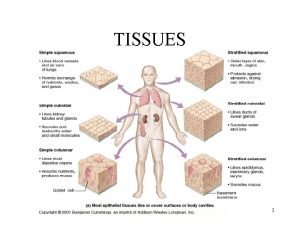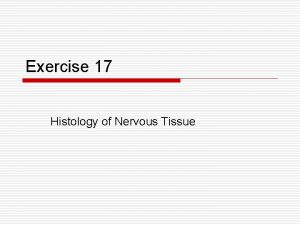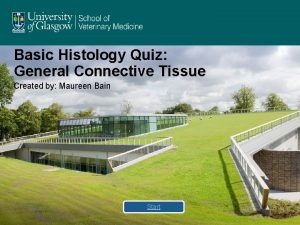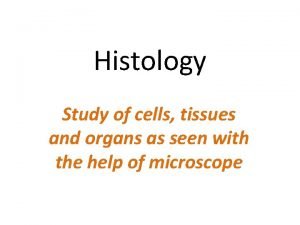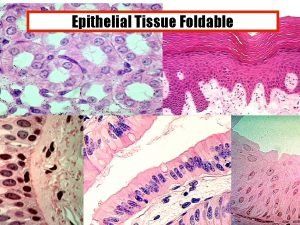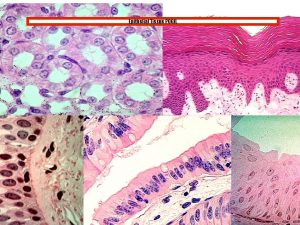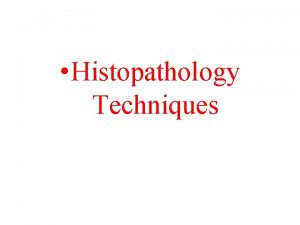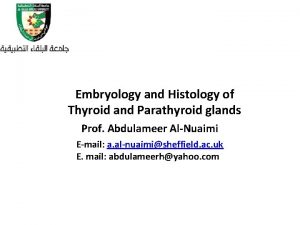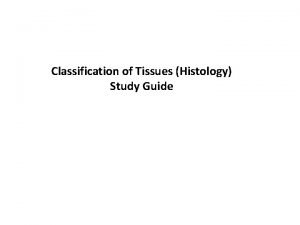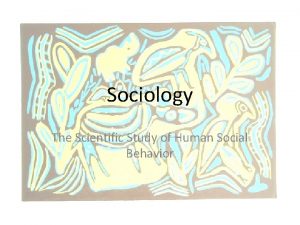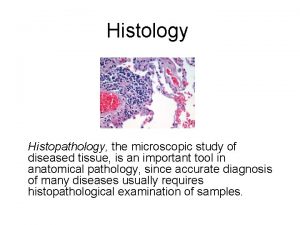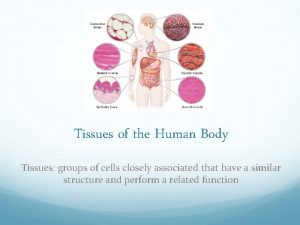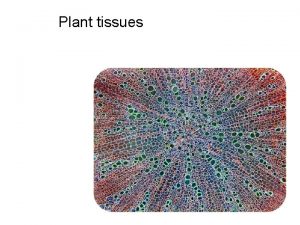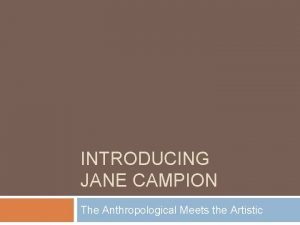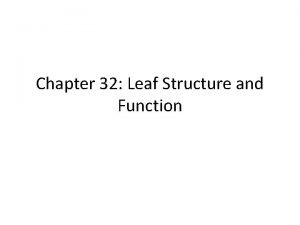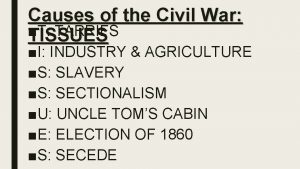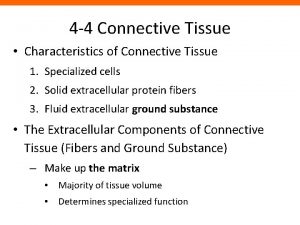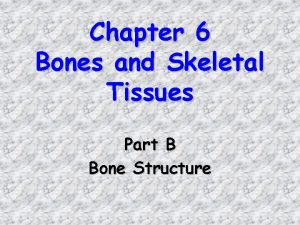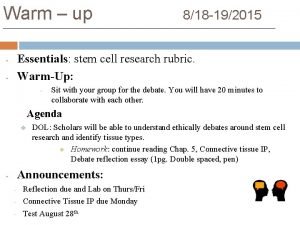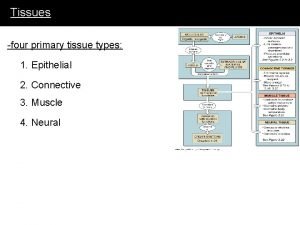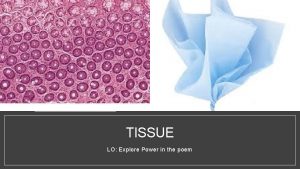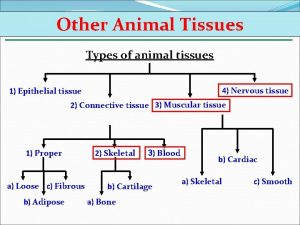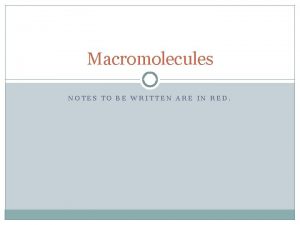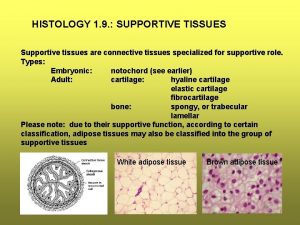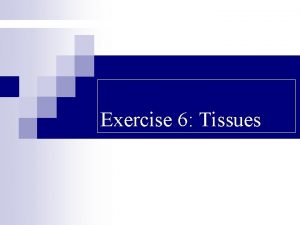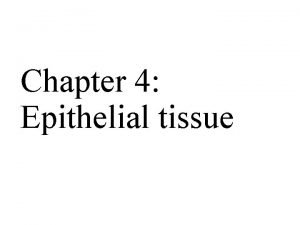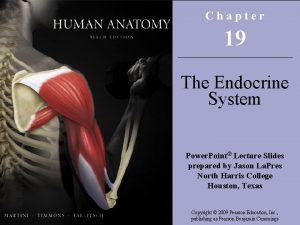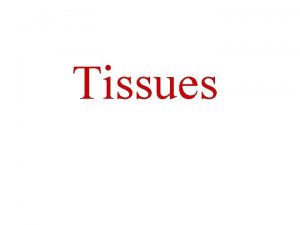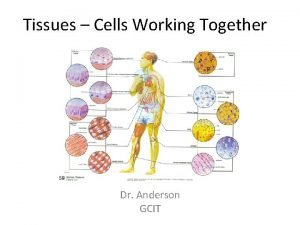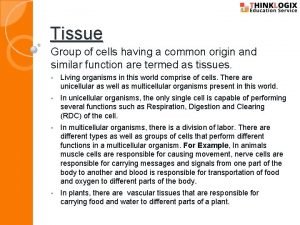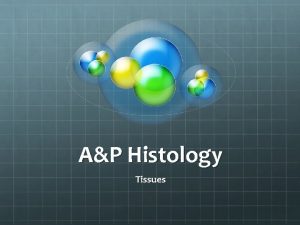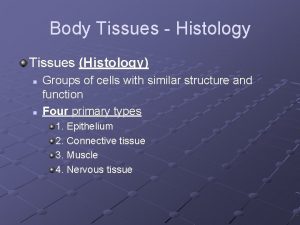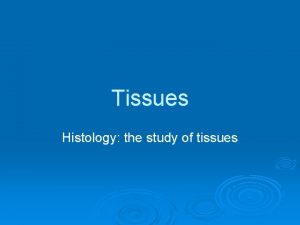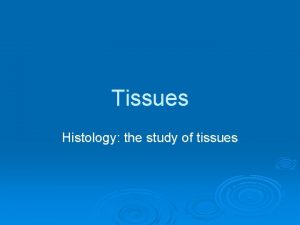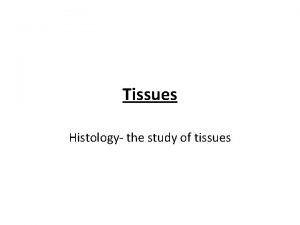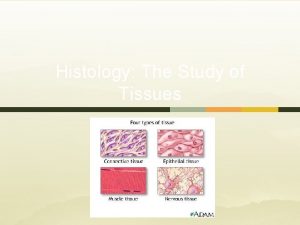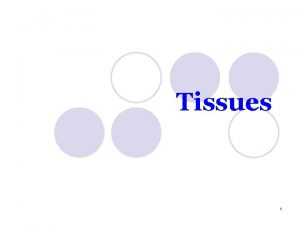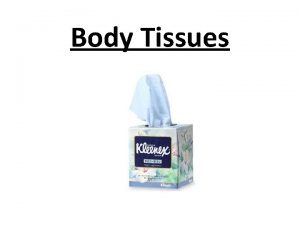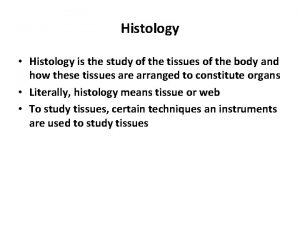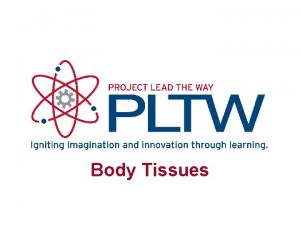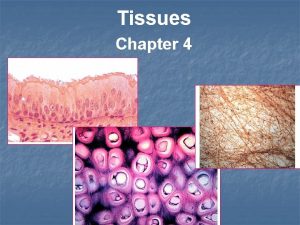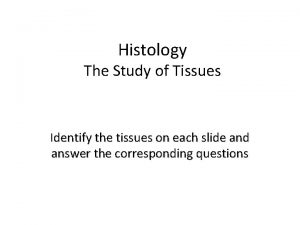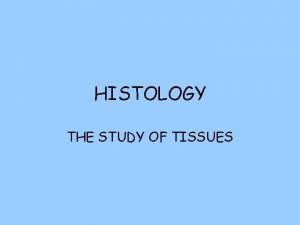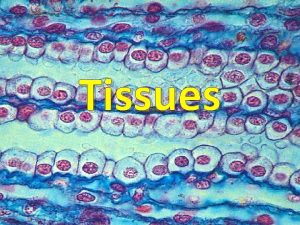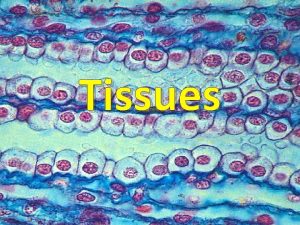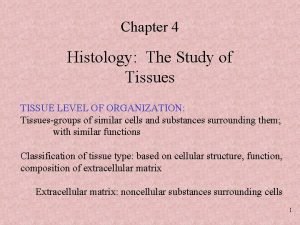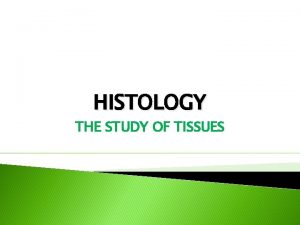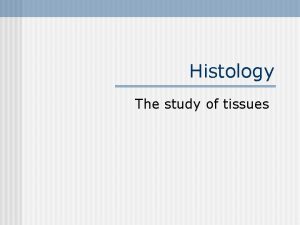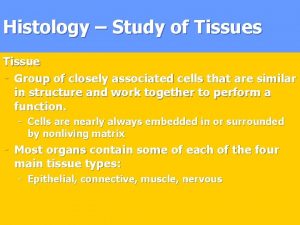Tissues Histology the study of tissue Groups of




















































- Slides: 52

Tissues Histology- the study of tissue Groups of cells that are similar in structure and perform a common or related function.

4 primary types: Epithelial (covering) Connective (support) Muscle (movement) Nervous (control)

Epithelial- Used for covering (ex: organs) or Glands

Epithelial Functionprotection, absorption, filtration, excretion, sensory reception

Characteristics of Epithelial: -Innervated -Avascular -High regenerative capacity -Polar- Apical surface= free -Basal surface= attached -Lots of cells / form sheets

2 names for epithelia: Layers: simple or stratified Shapes: Squamous Cuboidal Columnar

Simple Squamous- thin, permeable, for filtration or exchange, found in lungs, kidneys

2 types: Endothelium- inner covering, slick friction reducing lining vessels Mesothelium- middle covering lining the ventral body cavity

Simple Cuboidal- secretion and absorption, found in glands

A gland consists of one or more cells that make and secrete a product

Endocrine gland- ductless, absorb and secrete product by diffusion (thyroid, adrenals, pituitary) Exocrine gland- ducts (salivary, oil, liver, pancreas)

Simple Columnar- lines the digestive tract from stomach to rectum

Examples: • Microvilli- lines intestines, absorbs nutrients • Goblet Cells- secretes protective lubricating mucus

Stratified Squamous • Stratified Squamous- is most widespread. Thick, protective, and is the external part of skin. Covers tongue, lines mouth, throat, esophagus, anal canal, vagina

• Epidermis- the outer layer of the skin that contains a protective protein called keratin

• Stratified cuboidal and stratified columnar are rarer types-found in sweat glands, salivary glands

Connective Tissue

2 Parts Cells (living) • Fibroblast • Chondroblast • Osteoblast • Hemocytoblast Matrix (non-living) 1) Ground Substance: • Amorphous material 2) Fibers: • Collagen • Elastin • Reticular

Mesenchyme (embryonic origin) Fibroblast Chondroblast Osteoblast Hematoblast Fibrocyte Chondrocyte Osteocyte Connective Tissue Cartilage Proper Bone Blood Cells Blood

Connective Tissue Proper 1) Loose Connective * Areolar * Adipose * Reticular 2) Dense Connective * Regular * Irregular

Areolar (connective tissue proper) • Gel like, wraps and cushions organs-found in blood vessels, muscles

Adipose (fat) connective tissue proper • Matrix contains stored neutral fat oil • Shock absorber and insulator

Reticular Connective tissue proper • Forms a soft internal skeleton (stroma) • Found in lymphoid organs-spleen, thymus, lymph nodes

Dense Regular connective tissue proper • Parallel collagen fibers • Tendons, Ligaments

Dense Irregular connective tissue proper • Thicker bundles of collagen fibers • Forms sheets in body areas where tension is exerted in different directions • Fibrous joint capsules, dermis

Cartilage -Tough but flexible -Avascular -Devoid of nerves -80% water -Heals slowly

Cartilage-3 Types • 1) Hyaline Cartilage • 2) Fibrocartilage • 3) Elastic Cartilage

1) Hyaline Cartilage • • embryonic skeleton ends of long bone costal cartilage (rib) Nose trachea, larynx supports, reinforces flexible

Fibrocartilage Thick collagen fibers Intervertebral Discs

Elastic Cartilage • More elastin fibers • Ear, Epiglottis

Bone • 1) Compact bone • 2) Spongy bone

Bone • Hard calcified matrix • Very well vascularized • Gives support

Mesenchyme (embryonic origin) Fibroblast Chondroblast Osteoblast Hematoblast Fibrocyte Chondrocyte Osteocyte Connective Tissue Cartilage Proper Bone Blood Cells Blood

Blood • Various Complex Cells

Blood Atypical Connective tissue Blood Cells= macrophages, wbc, rbc Matrix= plasma Fibers=soluble proteins that are visible in clotting -Carries gas, nutrients, waste, etc. • •

Nervous Tissue

Makes up brain, spinal cord, nerves • Neurons- highly specialized nerve cells-generate and conduct nerve impulses • Supporting cells- no conductingsupport, insulate, and protect neurons

Muscle Tissue • Highly vascular • Highly cellular • Function= movement

Skeletal Muscle Tissue • Voluntary • Attaches to bone, skin • Gross body movements • Long cylindrical, many nuclei • Striated (banded)

Skeletal Muscle Picture

Cardiac Muscle Tissue • Involuntary • Walls of the heart • Striated • Branched • Fit together by intercalated discs

Cardiac Muscle Picture

Smooth Muscle Tissue -Involuntary -Function= to propel (squeeze) -Found in walls of hollow organs (uterus), digestive system, urinary system and blood vessels -Spindle shape -Central nucleus -NO STRIATIONS

Smooth Muscle Picture

Functions of Tissue Protection • Mechanical protection= (barrier) skin, mucosa • Ciliary protection= epithelial (trachea) • Chemical protection= glands

Inflammatory response • Occurs when tissues are injured • Non-specific

Immune Response • Specific • Takes longer to come to action • Involves antibodies

Tissue Repair • Three steps: –Inflammation –Organization –Regeneration

Inflammation • Histamine macrophage, mast cell • Capillaries dilate • Leak clotting proteins • Clot scab

Organization • Clot Granulation tissue • New blood vessels collagen fibers scar

Regeneration • Epithelial cells migrate across granulation tissue and thickens

The ability to regenerate: • Good: Epithelial (skin, epidermis, mucosa) • Limited: Smooth muscle, dense regular connective (ligaments, tendons) • Poor: Skeletal muscle, Cartilage
 Body tissue
Body tissue Body tissue
Body tissue Body tissues chapter 3 cells and tissues
Body tissues chapter 3 cells and tissues Cells form tissues. tissues form __________.
Cells form tissues. tissues form __________. Stained cheek cell
Stained cheek cell Tissues are groups of similar cells working together to
Tissues are groups of similar cells working together to Tissues are groups of similar cells working together to
Tissues are groups of similar cells working together to A group of cells similar in structure and function
A group of cells similar in structure and function Histology of nervous tissue ppt
Histology of nervous tissue ppt Sheeps brain
Sheeps brain Connective tissue histology quiz
Connective tissue histology quiz Stratified squamous epithelium
Stratified squamous epithelium Pogil definition
Pogil definition Pogil epithelial tissue histology
Pogil epithelial tissue histology Stages of tissue processing
Stages of tissue processing Parathyroid gland image
Parathyroid gland image Waldeyer's ring
Waldeyer's ring How are ethnic groups and religious groups related
How are ethnic groups and religious groups related Perforation plates
Perforation plates Tissue
Tissue Scientific study of social behavior and human groups
Scientific study of social behavior and human groups Itut
Itut The microscopic study of diseased tissue.
The microscopic study of diseased tissue. What is specialized connective tissue
What is specialized connective tissue What are the 4 types of tissues
What are the 4 types of tissues Plant tissue
Plant tissue 3 tissues of a plant
3 tissues of a plant Plant tissue and organs
Plant tissue and organs Jane campion tissues
Jane campion tissues Leaf tissues
Leaf tissues Tissues causes of civil war
Tissues causes of civil war Histology smooth muscle
Histology smooth muscle Connective tissues characteristics
Connective tissues characteristics Genetic effects on gene expression across human tissues
Genetic effects on gene expression across human tissues Adipose connective tissue functions
Adipose connective tissue functions Chapter 6 bones and skeletal tissues
Chapter 6 bones and skeletal tissues Types of tissues
Types of tissues Four primary tissues
Four primary tissues Connective tissue poem
Connective tissue poem Types of tissues
Types of tissues What macromolecule is a prominent part of animal tissues
What macromolecule is a prominent part of animal tissues Divisions of anatomy
Divisions of anatomy Supportive tissues
Supportive tissues What is this tissue
What is this tissue Identify this tissue
Identify this tissue Types of tissues
Types of tissues Which part of the cell contains genetic material
Which part of the cell contains genetic material Chapter 3 cells and tissues figure 3-7
Chapter 3 cells and tissues figure 3-7 Endocrine tissues
Endocrine tissues 4 major tissues
4 major tissues Tissues working together
Tissues working together Tissue is a group of cells having
Tissue is a group of cells having Tissues in the circulatory system
Tissues in the circulatory system






